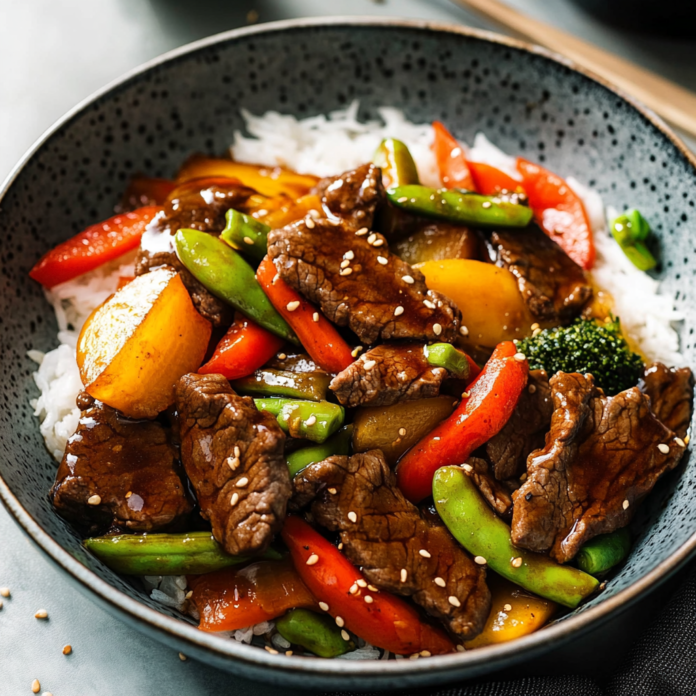Introduction and Quick Summary
If you’re looking for a quick and satisfying meal, the Beef and Vegetable Stir-Fry with Soy Sauce is your answer. This dish combines tender strips of beef with colorful vegetables, all tossed in a savory soy sauce. Perfect for busy weeknights or whenever you’re craving something delicious yet nutritious. The beauty of this stir-fry lies in its versatility; you can use your favorite vegetables or whatever you have on hand. You can whip up this dish in under 30 minutes, making it ideal for those hectic evenings when time is of the essence.
The rich flavor of the soy sauce complements the beef beautifully while the crunchiness of the vegetables adds texture. Not only is this recipe simple to follow, but it also packs a punch when it comes to nutrition. Incorporating various veggies increases fiber intake while providing essential vitamins. Plus, it’s a great way to introduce kids to the joys of cooking; they can help chop vegetables or mix ingredients together.
In this article, we will guide you through the main ingredients needed for this stir-fry, provide detailed preparation steps to ensure success in your kitchen, and offer tips on serving and storing leftovers. With just a few key ingredients and some basic techniques, you’ll be able to create a restaurant-quality meal right at home.
Main Ingredients
Beef
For this recipe, you will need one pound of flank steak or sirloin steak sliced into thin strips against the grain. The choice of beef cut is crucial as it affects both tenderness and flavor. Flank steak is lean yet flavorful while sirloin offers good marbling which enhances taste. Make sure to trim any excess fat before slicing to keep the dish light yet satisfying.
Vegetables
You can choose any combination of vegetables for your stir-fry. A mix of bell peppers (1 cup), broccoli florets (1 cup), snap peas (1 cup), and carrots (1 cup) works beautifully together. Each vegetable brings its unique flavor profile; bell peppers add sweetness while broccoli gives earthiness. Aim for fresh produce to maximize nutritional benefits and ensure vibrant colors that make your dish visually appealing.
Soy Sauce
You will require 1/4 cup of low-sodium soy sauce for seasoning. Using low-sodium options allows you to control salt levels without sacrificing flavor. Soy sauce acts as a marinade for the beef as well as a seasoning agent during cooking. If you’re looking for alternatives due to dietary restrictions, consider tamari or coconut aminos.
Garlic
Two cloves of garlic minced will add aromatic depth to your dish. Garlic not only enhances flavor but also offers numerous health benefits including anti-inflammatory properties. Freshly minced garlic provides a more robust taste compared to pre-minced varieties found in jars.
Ginger
One tablespoon of freshly grated ginger infuses warmth into your stir-fry. Ginger’s unique spicy-sweet flavor complements both beef and veggies beautifully while also aiding digestion—a perfect addition to any meal.
Cooking Oil
Use two tablespoons of vegetable oil or sesame oil for frying. These oils have high smoke points which make them ideal for stir-frying at high temperatures without burning easily. Sesame oil adds an additional layer of flavor that pairs wonderfully with Asian-inspired dishes.
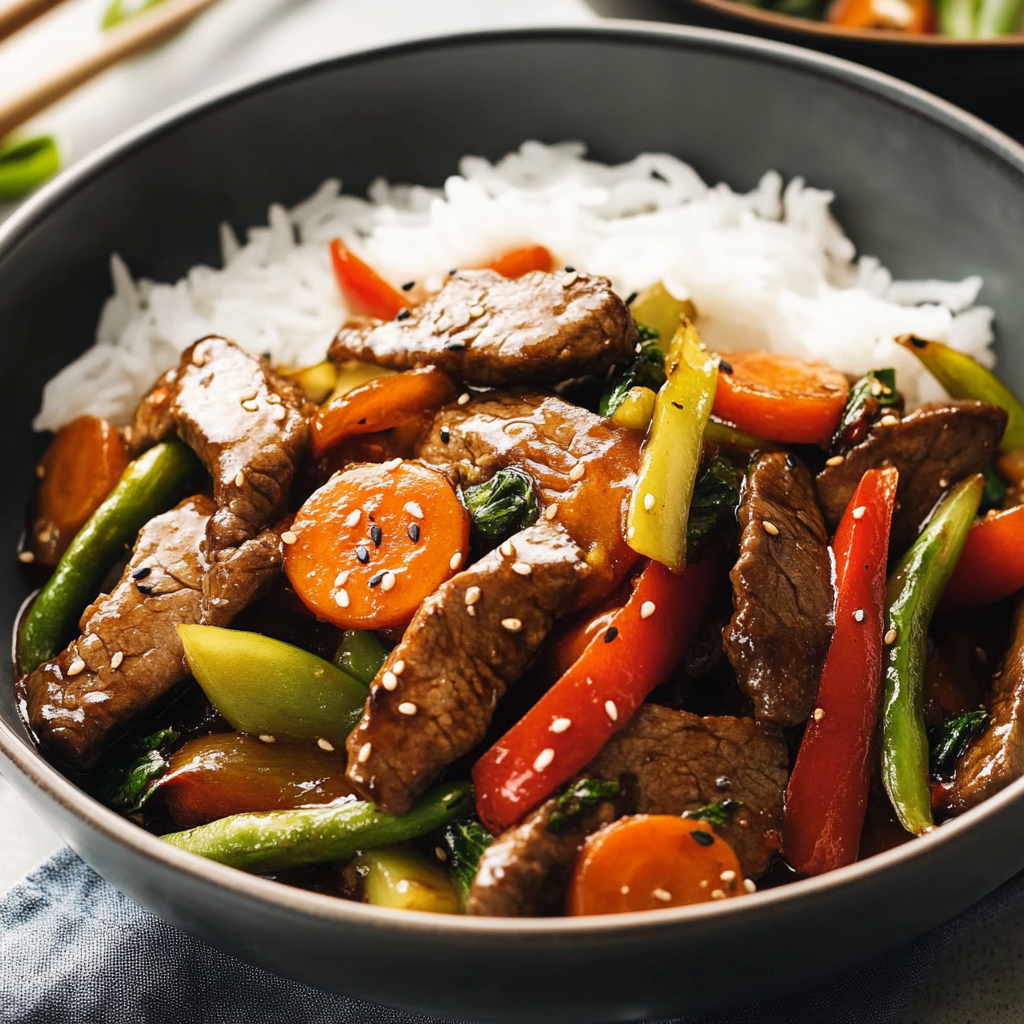
How to Prepare Beef and Vegetable Stir-Fry with Soy Sauce
Preparation Steps
Start by gathering all ingredients on your countertop—this helps streamline cooking processes later on. Begin by marinating your sliced beef in half of the soy sauce (1/8 cup), minced garlic, minced ginger, and 1 tablespoon of oil in a bowl. Allow it to sit for about 15 minutes while preparing other ingredients.
Next, wash all selected vegetables thoroughly under cold water then chop them into bite-sized pieces ensuring uniform sizes for even cooking. Set these aside along with any additional vegetables you may want to include based on personal preference.
Cooking Process
Heat the remaining tablespoon of oil in a large skillet or wok over medium-high heat until shimmering but not smoking—this usually takes around one minute depending on your stove settings.
Add marinated beef strips directly into the hot pan in a single layer without overcrowding to achieve that coveted sear effect; cook them undisturbed for about 2-3 minutes until browned before flipping over using tongs or spatula.
Once fully cooked (approximately 4-5 minutes total), transfer the beef onto a plate leaving behind any juices which will enhance flavors later when combining everything together.
Next up are those vibrant vegetables! Add them directly into the same skillet along with remaining soy sauce; toss continuously allowing everything to cook evenly—about 3-4 minutes should suffice until vegetables are crisp-tender yet still vibrant in color.
Finally return cooked beef back into pan mixing thoroughly so that flavors meld together seamlessly—cook everything together briefly ensuring no residual liquid remains before removing from heat source!
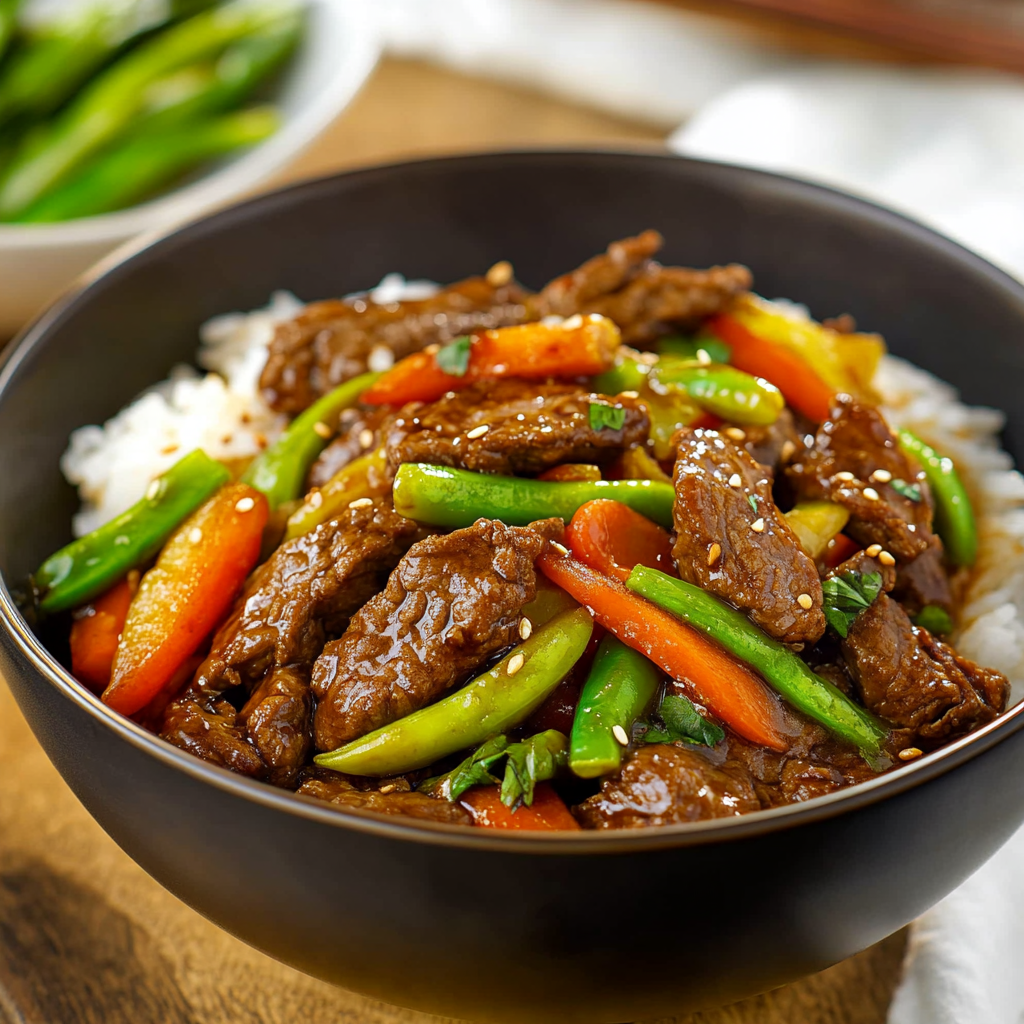
Serving and Storing Tips
Serving Suggestions
This delightful Beef and Vegetable Stir-Fry can be served immediately over steamed rice or noodles based on preference—white rice provides simplicity whereas brown rice adds nuttiness enhancing overall experience! For added freshness garnish plates with chopped green onions or sesame seeds elevating presentation further whilst providing crunch!
Consider pairing this meal alongside sides such as egg rolls or spring rolls giving variety without overwhelming palate! If dining al fresco style try serving within lettuce wraps creating fun handheld options!
Storing Leftovers
If you happen to have leftovers after enjoying this delicious meal don’t fret! Store any uneaten portions in airtight containers within refrigerator where they can last up until three days safely without compromising quality! Reheat quickly either via microwave safe container heating through intervals until warmed adequately!
For longer storage consider freezing portions within freezer bags labeled clearly indicating contents alongside date prepared ensuring maximum freshness retained upon reheating! When thawing always aim using lowest setting possible allowing gradual warming back maintaining texture integrity throughout process!
With these tips handy you’ll enjoy every last bite worry-free knowing how best preserve flavors enjoyed initially!
Mistakes to avoid
When preparing a Beef and Vegetable Stir-Fry with Soy Sauce, avoiding common mistakes can elevate your dish. One significant error is overcooking the beef. Many cooks tend to leave the beef on the heat for too long, which leads to tough and chewy meat. Instead, aim for a quick sear over high heat. This method locks in juices and flavor while ensuring tenderness. Remember, the beef will continue cooking slightly after being removed from the heat due to residual warmth.
Another mistake is overcrowding the pan. When you add too many ingredients at once, it causes a drop in temperature, resulting in steaming rather than frying. This affects texture and flavor. To prevent this, cook in batches if necessary, allowing each component enough space to brown properly.
Using low-quality sauce or too much soy sauce can also ruin your stir-fry. While soy sauce is essential for flavor, using an excessive amount can make your dish overly salty. Opt for a good quality soy sauce and consider adding other complementary sauces like oyster sauce or hoisin to enhance the flavor profile without overwhelming saltiness.
Finally, neglecting to prepare vegetables properly can lead to uneven cooking. Cut vegetables into uniform sizes for even exposure to heat. Harder vegetables like carrots should be sliced thinly or blanched before adding them to the stir-fry, ensuring they cook through without overcooking more delicate items like bell peppers or snow peas.
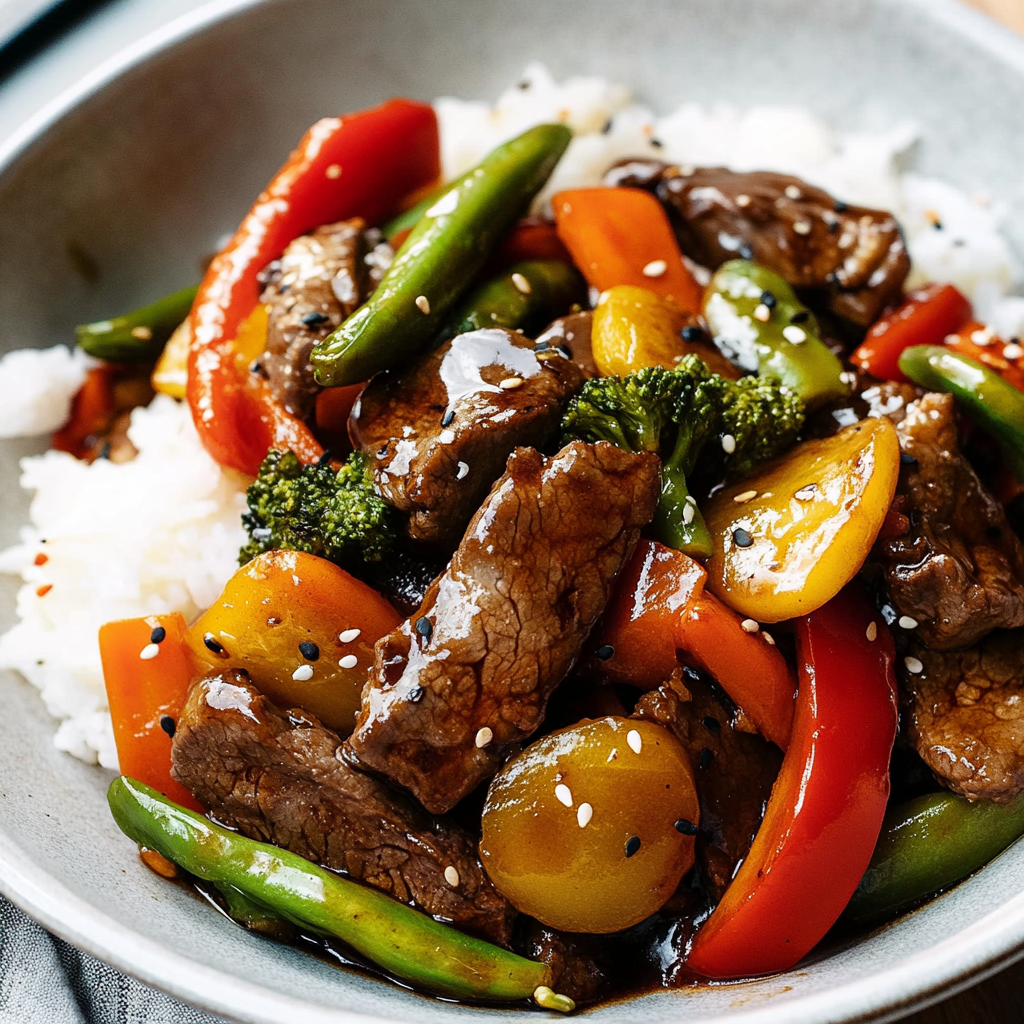
Tips and tricks
To master your Beef and Vegetable Stir-Fry with Soy Sauce, follow these key tips that will enhance both flavor and presentation. First, marinate your beef beforehand. A simple marinade of soy sauce, garlic, and ginger enhances the meat’s flavor significantly before cooking begins. Even 15-30 minutes of marination can make a difference in taste.
Next, use high heat when cooking; this helps achieve that signature stir-fry texture—crispy on the outside while remaining tender inside. A well-seasoned wok or non-stick pan works best for this technique because it allows ingredients to move freely without sticking.
Incorporating an array of colorful vegetables not only adds nutrients but also makes your dish visually appealing. Consider using bell peppers, broccoli, snap peas, and carrots for a vibrant combination that draws attention on any plate.
Another useful tip is timing your vegetable additions wisely; add denser vegetables first while reserving softer ones until later in the cooking process. For instance, start with carrots and broccoli before tossing in bell peppers or bean sprouts near the end of cooking.
Lastly, finish your stir-fry with fresh herbs like cilantro or green onions for an aromatic touch right before serving. These fresh elements brighten up the dish and create depth of flavor that complements the savory notes from the soy sauce.
Suggestions for Beef and Vegetable Stir-Fry with Soy Sauce
Creating a memorable Beef and Vegetable Stir-Fry with Soy Sauce requires thoughtful ingredient choices and techniques. First off, select the right cut of beef; flank steak or sirloin works beautifully due to their tenderness when cooked quickly at high temperatures. Slice against the grain to ensure every bite remains tender.
Consider experimenting with different types of vegetables based on seasonality or preference; seasonal produce often tastes better and provides freshness that enhances any stir-fry dish. For example, zucchini during summer months adds moisture while mushrooms lend earthy tones.
When it comes to sauces beyond traditional soy sauce, think about incorporating garlic chili paste or sriracha if you enjoy a kick of spice in your meal. Balancing these flavors with sugar or honey helps create a well-rounded taste that’s not overly salty.
For those looking for healthier options, you might consider reducing oil usage by opting for non-stick pans or using an oil spray instead of pouring oil directly into the pan. This approach cuts calories without sacrificing flavor.
Lastly, serve your stir-fry over a base that complements its richness; steamed jasmine rice or quinoa are excellent choices that absorb flavors well while providing texture contrast against tender beef and crisp vegetables.
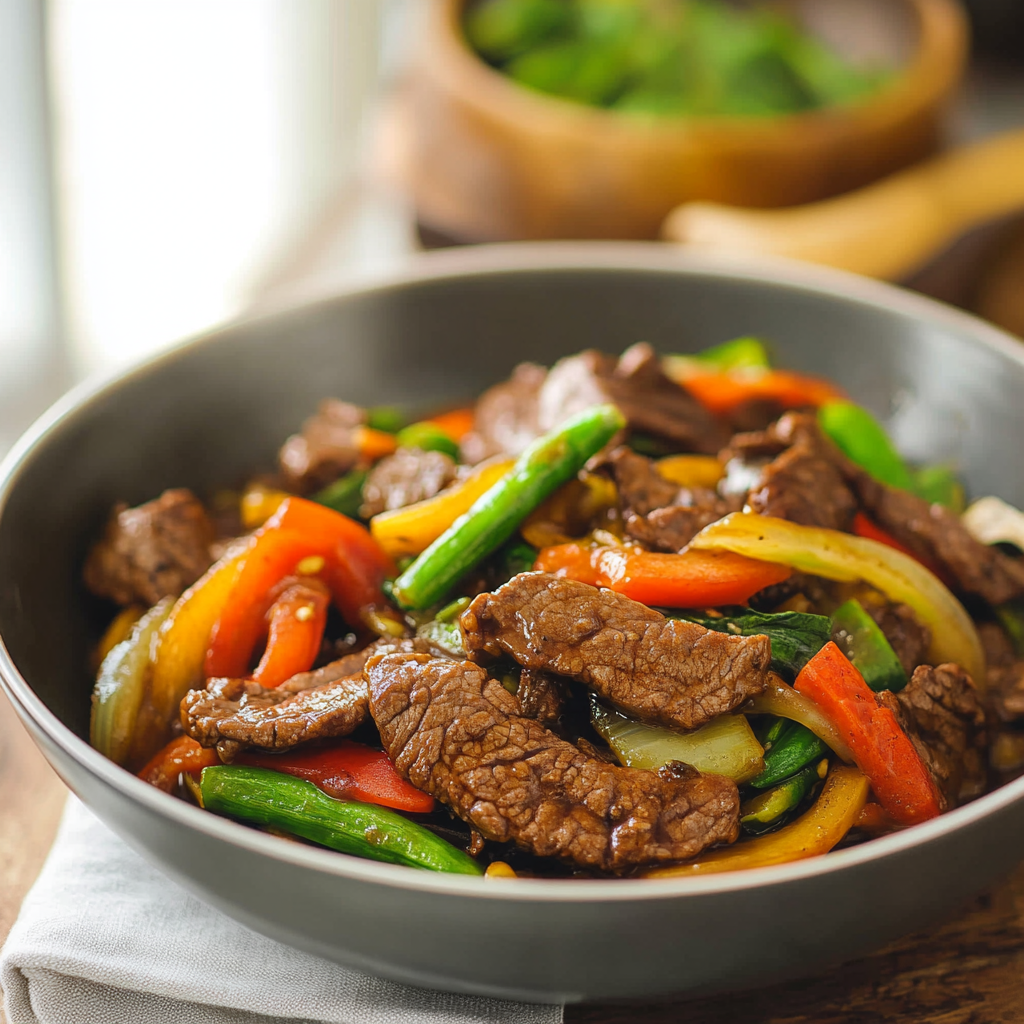
FAQs
What cut of beef is best for stir-frying?
Choosing the right cut of beef is crucial for making an excellent Beef and Vegetable Stir-Fry with Soy Sauce. Flank steak is highly recommended due to its rich flavor profile and tenderness when sliced thinly against the grain after cooking. Sirloin is another excellent option as it offers similar qualities but may require slightly longer cooking time compared to flank steak due to its thickness. For even more convenience, pre-sliced options are available at many grocery stores; however, always check if they are sourced from reputable suppliers to ensure quality.
Can I use frozen vegetables instead?
Yes! Frozen vegetables are a great alternative when fresh produce isn’t available for your Beef and Vegetable Stir-Fry with Soy Sauce recipe. They are usually flash-frozen shortly after harvest which helps retain their nutrients and flavors effectively compared to older fresh options available at stores sometimes lacking vibrancy due to extended shelf life duration before purchase. Just remember that frozen veggies may contain excess water; thaw them first before adding them into hot oil during cooking steps so you don’t end up steaming instead of frying!
How do I store leftovers?
Storing leftovers from your Beef and Vegetable Stir-Fry is simple yet important for maintaining flavor integrity over time while also ensuring food safety practices are upheld diligently! Allow leftover stir-fried ingredients cool down completely before transferring them into airtight containers; this prevents condensation buildup which could lead detrimental effects such as sogginess over time once refrigerated properly within two hours post-preparation ideally! Consume within three days maximum after refrigeration has occurred—reheat thoroughly prior consumption again upon reheating either on stovetop medium heat or microwave until piping hot throughout!
Is it possible to make this dish vegetarian?
Absolutely! You can easily adapt Beef and Vegetable Stir-Fry with Soy Sauce into a delicious vegetarian version by substituting beef with tofu or tempeh as protein sources instead! Firm tofu holds its shape well when stir-fried while absorbing flavors beautifully from marinades used previously—just remember pressing out excess moisture beforehand ensures optimal texture retention post-cooking process completion! Additionally feel free exploring various colorful seasonal vegetable options abundant around local markets enhancing nutrient diversity providing wholesome satisfaction across all dietary preferences!
Can I use other types of sauces besides soy sauce?
Indeed! While traditional recipes typically call for soy sauce as primary seasoning element within dishes like Beef & Veggie Stir Fry—other sauces could complement wonderfully offering diverse flavor profiles beyond classic tastes alone! Teriyaki offers sweetness along with savory notes whereas oyster sauce brings depth through umami characteristics appealingly enriching overall experience enjoyed by diners alike! Feel free experimenting creatively establishing unique combinations reflecting personal preferences truly elevating culinary experience enjoyed by everyone involved!
What side dishes pair well with stir-fry?
Pairing side dishes alongside your flavorful Beef and Vegetable Stir-Fry enhances mealtime enjoyment significantly! Steamed jasmine rice serves as traditional accompaniment soaking up delicious juices effortlessly while providing filling base beneath vibrant colors presented atop plates visually stimulating diners’ appetites further intensifying overall satisfaction derived from hearty meal experienced together shared among loved ones gathered around dining table ready sharing memories created deliciously together forever cherished moments enjoying culinary delights made lovingly prepared!
Conclusion
In conclusion, mastering a Beef and Vegetable Stir-Fry with Soy Sauce involves avoiding common mistakes like overcooking ingredients and overcrowding pans. Marinate the beef ahead of time and cook on high heat to seal in flavors while ensuring vegetables remain crisp and vibrant. Select fresh, high-quality ingredients for the best results. This dish is versatile, allowing substitutions such as chicken or tofu for variety, while proper storage methods extend its life. Cooking together fosters bonds and creates cherished memories. Embrace the joy of sharing flavorful creations with loved ones, celebrating the art of cooking and connection. A well-prepared stir-fry transforms simple ingredients into a delightful meal, showcasing the power of thoughtful preparation, technique, and care. These experiences enrich our lives, reminding us of the simple joys of gathering around the table, savoring great food, and nurturing relationships that resonate long after the meal is over.
